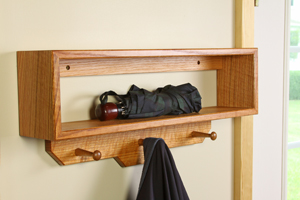
I have found some black oak and was wondering how it compares to white or red oak. I have never used it or ever run across it before. I noticed that it is very hard and heavy. Any information you can tell me about it would be appreciated. – Lester Mellott
Rob Johnstone: Lester, thanks for your question. To come completely clean, I had to do some research on the name black oak. I had always assumed that it was a local name or a nickname for some “regular” type of oak. I have never knowingly used black oak, which is apparently a sub-species that is legally sold as red oak. At least, that is the case if we are talking about the Eastern variety. There is a California black oak as well. The research I have done on this West Coast version brings up contradictory statements, with some saying that it is not commercially used and others saying that it is sometimes sold, but when it is, there is a distinction made to keep it from being confused with the Eastern variety. With all of that said, I actually can’t answer your question about how it works in terms of woodworking. As you may know, within the category of red oak there is a variety of species with varying characteristics. Sorry I can’t be more helpful, but thanks again for helping me gain a bit more knowledge of what exactly black oak truly is.
Chris Marshall: Prior to finding this publication from the U.S. Forest Service click here, I never knew that I had used black oak. But curiously, they say “the wood, commercially valuable for furniture and flooring, is sold as red oak.” So, it’s possible that I’ve used a whole bunch of black oak after all, sold as good old, reliable red. Hope this link is helpful for you.
Tim Inman: There are thousands of oaks; red and white are two common sub-classifications. My understanding is that there is actually a “black oak” tree, and there is lumber referred to as “black oak” which may or may not be cut from the named tree. Burr oak is sometimes referred to as a “black oak.” Regardless of the botany, the “black oak” I’ve worked with is as you have described it: hard, heavy and pretty grainy. It seems to be very stable, and makes a great utilitarian wood for jigs and fixtures, etc. I often use it as a “working wood” for things I make in my shop. (I own an acreage of timber which contains many burr oaks. So, I have quite a bit of it cut and on the ready in my storage pile.) It stains to a nice dull “antique” brown, and looks like most white oaks in furniture. It is definitely a nice wood to have and use, in my view.





